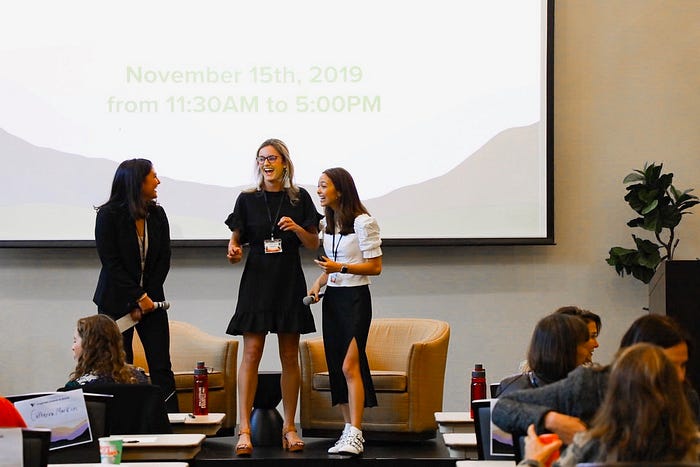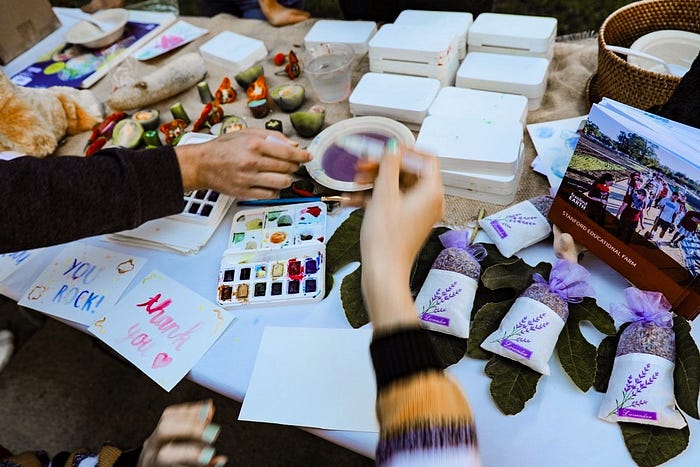Designing for Her: Keeping Mother Nature in Mind
Stanford Womxn in Design Annual Conference
Written by Maria Metzger

Design as an interdisciplinary field manifests in countless ways, even within the framework of sustainability. I’m a member of Stanford Womxn in Design, an organization of undergraduates, alumni and mentors. We focus on forming community and connections while providing opportunities for design education in the Stanford community at large. We are composed of six teams that work together to inspire creative confidence in designers, and our biggest event of the year took place Friday, Nov. 15 in Paul Brest Hall.
I feel lucky to be an intern for the Special Projects team, directed by Jensen Neff (’20) and Ellie Chen (‘20), who worked for months with SWID President Nicole Orsak (’21) to create this incredible day. Speakers from Brandless, Baggu, Patagonia, Allbirds, IDEO, Impossible Foods and the Exploratorium came to share their stories and wisdom with members of the Stanford community and beyond. The audience buzzed with inspiration and excitement all day, and I’m incredibly grateful for the opportunity to learn from these women and for all who attended.

To kick off the conference, Tina Sharkey, the co-founder of Brandless, discussed what she’s learned throughout her career, moderated by her college best friend, Chinita Hard. Sharkey casually helped coin the term “social media” and looks through the lens of entrepreneurship as a way to solve problems and bring extraordinary people together. Brandless maintains a company-wide intention to be as sustainable as possible, Sharkey asserting that “you need to continually disrupt yourself” to find the best design solutions. Sharkey thinks outside the box even when it comes to boxes, unapologetically reusing boxes for shipping and packaging and suggesting ways that the consumer can repurpose boxes themselves.
When asked for her greatest insight, Sharkey discussed the flaws in viewing success as something always in front of you. She believes that there’s a crucial stretch from success to significance in making an impact in the world. Sharkey knows that it’s essential to “use all of your skills that are ‘orthogonal’ to your day job. The only thing that scales is your authentic self. If that doesn’t work, then you are in the wrong job!” By willing to go the extra mile in her work, she has made a great impact. Her passion for authenticity inspired me.

We then transitioned to a delicious lunch catered by Mendocino Farms and Oren’s Hummus. I did not go hungry with so many vegetarian and vegan foods, bringing earth-conscious practices into our food consumption with compostable plates and utensils. I enjoyed Munger’s beautiful scenery while dining with fellow SWID members.

Next up was the Retail Panel, with Ellen Vanderlaan from Baggu, Lizzy Morrison from Patagonia, and Elena McCallister from Allbirds, moderated by Jensen Neff and Ellie Chen. I had been looking forward to this panel for weeks, wanting to understand how the consumer sector and sustainability intersect. These three companies have come to prioritize sustainability in different ways, knowing that the first step to get there is by creating a great product.
For Vanderlaan, this takes form in Baggu reusable bags that are “so beautiful that you’d rather carry them anyway.” Vanderlaan enjoys working within the constraints of the four recycled materials they’ve manufactured, being creative with the patterns and colors she designs. Elena McCallister of Allbirds agrees, explaining that educational opportunities come with great products. The unmatched comfort and unique style of their shoes attract consumers who appreciate the beauty of sustainable materials. Allbirds’ “sustainability task force” continually works to carry their founding mission through their production.
With an increasing societal appetite for sustainability in branding and consumption, these companies can have a major impact on our environmental awareness. Color designer Lizzy Morrison knew she wanted to align herself with a company like Patagonia because of their commitment to the environment and focus away from trend-based design. She helps choose the 90 colors aligned with specific natural themes for each seasonal line, currently designing for Fall 2021.
With companies of Patagonia’s status, the question of affordability and accessibility is raised. Morrison responds to this, “Our price point may be high, but we want consumers to buy a product once and wear it forever.” By emphasizing this lifetime guarantee, Patagonia slows down the process of consumption and encourages thoughtful investment into singular products.
Another question arises concerning the balancing of consumerism and sustainability. Ellen Vanderlaan admits, “really the best thing that we could do for the environment is to not make more products,” but the value, function, longevity and delight of their bags justify their production. Not to mention, the impressions that these companies make on people are invaluable; I believe it’s most effective to educate people through the products they buy and love. Elena McCallister shares the story of an Allbirds-wearer who told her that “every day he wears his Allbirds, he looks down to remind himself of what else he can do to help preserve the planet…whether it be recycling or skipping the straw.”

The wonderful Activities Fair was next, with vegetable watercolor painting and card-making by the Stanford Educational Farm, a Fashion X table and yogurt container decorating to repurpose as pots for flowers and succulents from the vertical garden. I loved seeing everyone’s energy and excitement exhibited in hand-made crafts. We were also treated with Salt and Straw ice cream, with a delicious vegan option!

With a healthy sugar high, I headed back inside for the much-anticipated Food Systems Panel. Rachel Maloney from IDEO and Ashley Geo from Impossible Foods shared insight into how design functions in the culinary and nutritional realm, both approaching it with our planet as the priority. Diane Dwyer moderated the panel, first asking about what led them to these special careers.
Ashley Geo studied HumBio at Stanford and slow food in Florence, questioning the sustainability of the prevalence of meat and cheese in Italian cuisine. With this knowledge, she was recruited to Impossible Foods in 2015 and now is their Head of Content and Digital Marketing. Rachel Maloney went to design school and “fell in love with waiting tables,” realizing that she was always talking about food as an environments designer. Though she initially wrote off her passion for food as a hobby, Maloney pursued it and joined the food studio at IDEO, where she talks about, makes and fixes problems with food.
For Maloney, sustainable food means “feeding ourselves without depleting natural resources.” She carries this definition with her when consulting with and digging into the values of companies, aiming to change our food system. Impossible Foods has a distinctive perspective, as Geo explains, “we believe in GMOs because that’s how we will sustainably feed the world.” Her definition of sustainability is based on resources, and the company’s mission is to “eliminate animal agriculture for the sake of making a truly sustainable food system,” which requires reaching the masses. Both of these definitions make a lot of sense to me, and it’s interesting how companies’ approaches to solving the same problem can be so different.
Similar to the retail sector, food must be delicious to make an impact. Having mastered this, Impossible burgers have moved into Burger King to reach even more meat-lovers at an accessible price. As a vegetarian, I appreciate this increasing accessibility of plant-based protein! Rachel of IDEO believes that the way to change the food system is cooking and loving delicious food with great conversations, encouraging us to throw beautiful dinner parties. The shift to less and higher-quality meat is a step in the right direction for our planet, but her main piece of advice is to be curious about what you’re eating and demand delicious food. I didn’t think about this before, but even in the culinary world, design thinking prevails as an effective way to incite positive change.

Last but not least, Shani Krevsky, Susan Schwartzenberg and Jill Fantauzza from the Exploratorium spoke about the museum’s sustainable practices and education methods. This interactive museum recently moved to the heart of San Francisco at Pier 15, in a historic warehouse building that was used for thriving waterfront commerce. I visited the Exploratorium as a child in its previous location, but really want to visit it now in its refreshed state.
The Exploratorium’s architecture is LEED-certified Platinum and utilizes 75,000 square feet of solar panels, using their building design to “do the heavy lifting for sustainability.” Project Director Shani Krevsky strives for more, aiming for a net-zero building. She will not stop finding new design solutions until the Exploratorium achieves this goal, but she celebrates victories that have gotten them to this point of sustainability and the site-specificity of their architectural design. The museum takes advantage of its large windows and natural lighting as well as the bay beneath it, using it as a geothermal exchange for their heating and cooling system.
Inside the Exploratorium, the goal is to “make people feel like they have civic agency,” says Schwartzenberg. Their hundreds of interactive exhibitions focus on various scientific topics, interweaving many of them with art. Schwartzenberg says that “people trust museums more than they trust science or governance,” which gives the Exploratorium great power to inspire and change people’s behaviors.
Their design process is very interesting in that exhibitions are made in-house, and their prototypes are pushed right onto the floor for visitors to react to and interact with. The Exploratorium’s design is clearly user-centered, and they start their creative process with the content area. Exhibition designer Jill Fantauzza explains that their goal is to give the visitor experience with the content and “the opportunity to parse through and think critically about the subject.” In designing this experience, the Exploratorium inspires people to do what they can to save our planet, which can come in all different forms.

With enthusiasm and appreciation, this incredible day was concluded by deconstructing the vertical garden which charmingly stood out front of Paul Brest Hall all day for visitors to enjoy. We all got to take this piece of the conference home with us, which beautifies my desk and reminds me to always keep Mother Nature in mind. So many of my interest areas converged that day: design, nutrition, fashion and sustainability! Thank you to all of the speakers, attendees and Stanford Womxn in Design members for making this such a special, inspiring day. I can’t wait to attend next year’s conference and other events to come!

